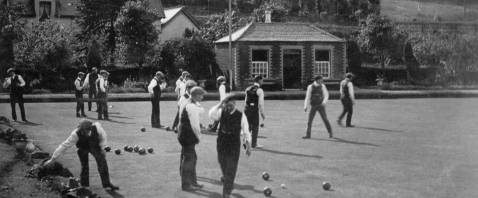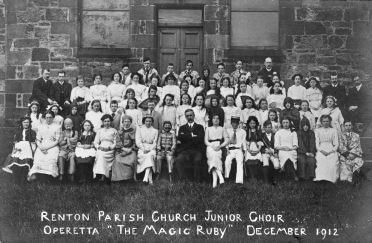RENTON A BRIEF HISTORY from 1715 to 2008 - Page 3
Page 1 | Page 2 | Page 4 | Page 5
At the beginning of the 19th century therefore, Renton was a thriving 28-year old village, well established around its core layout and an expanding network of streets, with its population working in two major and growing factories, which were to sustain it for the next 100 years. The Rentonian character and sense of values were already well in evidence - independence, civic pride and respect for knowledge.
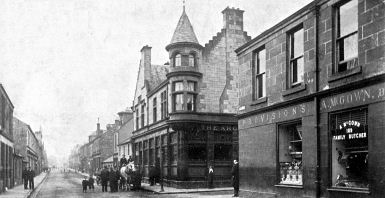
Renton Cross (Click to Enlarge)
The houses were mainly typical workers houses of the time - single story terraces - a number of which survived until the 1950's and early 60's, which became prone to overcrowding and unsanitary conditions as the 19th century wore on. However, these were problems of success - people wanted to come and work and live in Renton. In the first half of the 19th century, many of these people were Highlanders from Argyllshire and Loch Lomondside who had originally come to work in the bleachfields in the summer as seasonal workers, but migrated to permanent jobs as the Highland clearances began to bite, and also as working processes changed to generate year-round work.
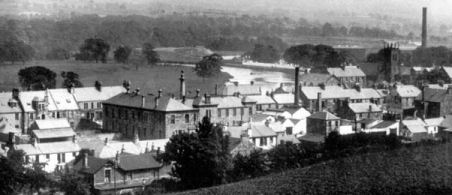
The Gaelic Free Church built in 1856 has already been noted as evidence of this migration. The 1820's saw further innovation - in 1827 a second school was opened - a charity school supported by subscription, while in the 1820's, the Renton Cattle Fair was started on Carman Hill. The site of the Fair was on land just to the south west of the dam, which is still recognisable as the Fair site with drove roads leading to it from all directions on the hillside.
This Cattle Fair, held each August, was originally started in Dumbarton, but moved from there to a site close to Pappert on Dumbarton Muir, before settling into its final location on Carman in the late 1820's. It lasted until about 1896, and 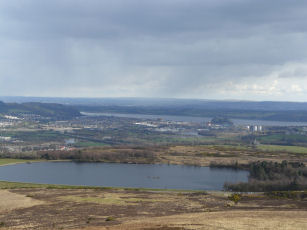 in its heyday was one of the most important cattle fairs in Scotland, with announcements about it even appearing in the London papers.
in its heyday was one of the most important cattle fairs in Scotland, with announcements about it even appearing in the London papers.
Renton Reservoir from the top of Mount Mallow. (Click to Enlarge)
The days of the fair, in August each year, were a local holiday with large crowds attending - after the railway came to Renton, special trains were laid on to bring crowds from Clydeside. Drink flowed freely - the shepherd's cottage, which was adjacent to the site, acted as a pub while the fair was on - and melees frequently ensued - as indeed they did at the Balloch Horse Fair.
The 1856 Fair seems to have been the occasion of a particularly violent punch-up, which had sectarian overtones to it, since it involved local factory workers and shipwrights from Dumbarton in fights with Irishmen who had by now come into the area to work. This could well have been a continuation of disturbances that started in Dumbarton in 1855 after Orange meetings were held in the burgh. It highlights that by the mid 1850's there were a significant number of Irish people 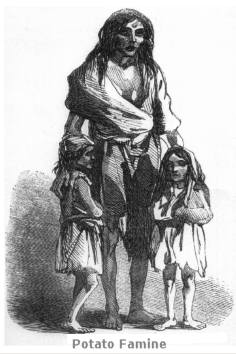 in the Vale, and in Renton.
in the Vale, and in Renton.
They were escaping the Potato Famine of 1847 - 48 which killed millions in their own land, and as well as working on the building of the railway, they worked in the construction of the modern brick-built factory buildings which characterised the Leven's banks during the 1850's and 60's, and then in the factories themselves.
Most of the factory buildings which remained until recently, for instance at Dalquhurn and still at Dillichip and the Craft, were in fact built from about 1850 onwards, replacing older much smaller sheds in most of the factories.
From the 1850's and 60's onwards, newer, more substantial tenements and houses began to replace the older buildings in Renton and that process continued for the rest of the 19th century. Indeed the two oldest houses presently still standing in Renton - Argyll Cottage (built 1866) and the adjoining 20 –22 main Street building (built very shortly after Argyll Cottage) date from 1866 - 61.
The railway opened in Renton in 1850, and the railway line provided the western boundary of the housing in the village (although McLaughlin's Farm is clearly an enduring feature of Renton). Perhaps surprisingly, the line still is the western boundary - apart for some fine red sandstone villas built on the hillside above the line over 120 years ago in the 1880's. In 1864 the principle streets were Main Street and Back Street, Red Row, Stirling, Burn, Thimble and King Streets, while a Station Street had been added. There was also a Market Street, but it has disappeared.
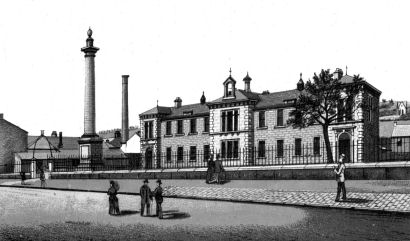
Renton Public School (Click to Enlarge)
The 1870's and 80's saw considerable development of housing and commercial premises on Main Street with many new shops and banks opened. After the 1872 Education Act, the village school which had already moved onto the site adjacent to the Smollett Monument, which it, and its successor, still occupy, was considerably expanded and took on the appearance that it had for most of the twentieth century. Donald MacLeod in his “History of Dumbarton, Vale of Leven and Loch Lomond” written in 1884, and published in 1886 writes of “scores of new, well finished, comfortable houses for the working classes, and its imposing plate-glassed thriving business premises… hardly recognisable from a quarter of a century ago”, and indeed that was largely how Main Street looked until the late 1950's.
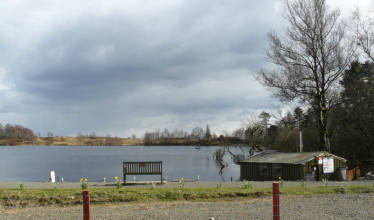
Carman Loch, the old Renton Reservoir (now a trout fishery)
Another Rentonian “do it yourself” exercise arose in the 1880's over the town water supply. By now, Renton's population was over 4,000 people and water and sanitation were a major issue - as they were in the rest of the Vale. The Vale, in the shape of Bonhill Parish Council, was pursuing plans to extract water from Loch Lomond, but since Renton was not in Bonhill Parish, it was excluded from these plans. No matter, the people of Renton drew up a scheme based on an expansion of Carman Loch, and the new water system was opened in 1886, and outlasted the Vale scheme by nearly 60 years, being in use until the 1960's.
The development of the village continued through the 1880's and 90's, particularly with the extension of the village southwards. The Renton Public Hall was opened in 1883, being built on a corner of what was then the Public Park on the corner of Hall Street and Main Street. This was the beginning of a colourful life for the building, which later saw it known not only as the Picture House from 1919 - 20, (although it had been licenced to show movies from 1912) then the Roxy Cinema until 1960.
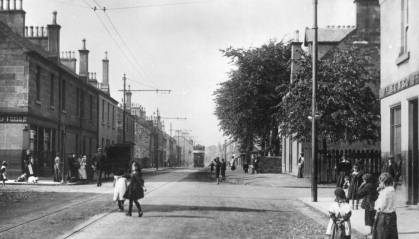
Renton Main Street (Click to Enlarge)
For a time in the late 1920's / early 1930's, Jack Short, who is perhaps better known as Jimmy Logan's father, was the manager of the cinema. Jack was famed for advertising the showing of the latest films of the time, on the same day as their release in London or Glasgow, instead of the couple of months that it took for them to filter down to the Roxy. No one believed him, of course, but instead filled the hall with people eager to see his virtuoso performance of apologising to the good people of Renton for being let down by some rascally agent, and the promises of what he would do the said agent on their behalf. It ended its days as the Burroughs Social Club from 1960 - until the mid 70's when it was destroyed by fire, having lain derelict for a short time after the closure of the Burroughs Social Club. Houses now occupy the corner site.
The Victoria Institute was opened in 1887, and served as Renton Library for much of the 20th century, until the Labour regime running West Dunbartonshire Council until the 2007 election, in a bout of maliciousness which characterised their dealings with the Vale in general and Renton in particular, closed it down and it became an Islamic Centre in 2007.
About 1880, as a further sign of Renton's expansion a gasworks was opened in Back Street. A number of fine buildings were completed in the early 1890's, with two surviving ones which co-incidentally have spent most of their lives housing pubs - the Central Bar and The Kind Man (this is probably the name by which it is best known, although it did have many others) being erected in 1893 in the middle of Renton.
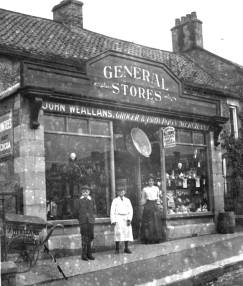 Expansion southwards was a sign of local prosperity and confidence which started in the 1870's and continued apace for the rest of the 1880's and 90's, with the southern end of Main Street being called Lennox Street, and new streets and houses being built at Leven, John and Alexander Streets.
Expansion southwards was a sign of local prosperity and confidence which started in the 1870's and continued apace for the rest of the 1880's and 90's, with the southern end of Main Street being called Lennox Street, and new streets and houses being built at Leven, John and Alexander Streets.
Weallans Store, Renton (Click to Enlarge)
In the short Alexander Street, a new Parish Church, the Trinity Parish Church (1891-2), Masonic Temple (1893) and Volunteer Drill Hall (1896) were all completed in short order. Therefore, within the space of 15 years or so, the southern end of Renton acquired a fine collection of sandstone buildings.
Tontine Park
Perhaps the most significant new development at this end of Renton happened in 1878 when a newly laid-out Tontine Park became the home of Renton FC. Renton FC was formed in 1872 just a few months after the formation of Vale of Leven FC. Renton FC was even quicker out of the blocks than its deadly rivals, when in only the Club's (and the Cup's) second season of 1874-75, to everyone's astonishment, Renton reached the Scottish Cup Final. In that first final Renton was defeated 3 - 0 by Queens Park, who were not only the current holders, but at that stage, the only holders of the Cup.
Between 1872 and 1877 the club played on a private park at the north end of the village, while in 1877 they played for one season somewhere close to Tontine, into which the club moved in 1878, although for some time the dressing rooms were 100 yards from the pitch. Eventually, the park was enclosed and a pavilion was opened in 1886 with a Grand Stand following shortly afterwards.
There were early ups and downs - in season 1881-82 Renton struggled to raise a team and had to scratch from the cup without playing a game, while only 3 years later, in 1885, the Cup was brought back to Renton for the first time. That it was Vale that they beat 3-1 in the final was very much an added bonus. Having won the cup again in 1888, Renton was invited to play the English Cup winners, West Bromwich Albion, for the “Championship of the World”. This title was no more far-fetched at that time than US baseball's present claim that their play-offs are “The World Series”.
In what was by all accounts a robust match played at Hampden on 19th May 1888, Renton emerged as worthy winners by 4-1. As can be imagined, bonfires on the hills lit a welcome for the homecoming team. Renton got to the Scottish Cup final again in 1895, when they lost.
Renton were the prime movers in the formation of the Scottish Football League in 1890, but ironically they couldn't participate in its first season in 1890-91, not appearing in it until the second season 1891-92, and only intermittently thereafter. The club was already in trouble because of the continuing loss of its best players to better paying clubs. In 1897 Renton FC was bankrupt and expelled from the Scottish League.
It was an abrupt and unhappy ending to a great club, brought about mainly by the money - even then - which enticed their best players to other clubs. One of the key players of the World Champions team, James Kelly, went off to play for the newly founded Celtic, and eventually became a director, founding a dynasty which played a key part in the Celtic boardroom until the arrival in the 1994 of Fergus McCann.
We received an excellent, detailed history of Tontine Park and Renton FC from a contributor to the magazine Groundtastic. This is available to read here.
 Renton FC's demise in 1897 was by no means the end of football in Renton, indeed its greatest footballer had yet to be born. The title “Wembley Wizards” has resonated in football since
Scotland defeated England 5 - 1 in March 1928. Scotland's greatest hero that rainy day was Alex Jackson, Scotland's tallest forward at a towering 5 ft 7 inches, who played at outside right. Scotland
was given no chance before the match, but on the park they ran England ragged, with Alex Jackson scoring a hat-trick.
Renton FC's demise in 1897 was by no means the end of football in Renton, indeed its greatest footballer had yet to be born. The title “Wembley Wizards” has resonated in football since
Scotland defeated England 5 - 1 in March 1928. Scotland's greatest hero that rainy day was Alex Jackson, Scotland's tallest forward at a towering 5 ft 7 inches, who played at outside right. Scotland
was given no chance before the match, but on the park they ran England ragged, with Alex Jackson scoring a hat-trick.
Jackson was born in Renton in 1905, and played his early football with Renton Victoria before being transferred to Dumbarton in 1922 for the princely sum of a new ball. He went to join his brother Wattie playing in America for a year 1923-4, before returning to join Aberdeen, then Huddersfield for a then record transfer fee of £5,000, and finally Chelsea where his first class career ended prematurely in 1932-33 season in a dispute over wages.
Jackson's career was blighted by the petty-fogging regulations of the day. His tally of international caps was ridiculously curtailed by the SFA deciding for a time that only players actually playing in Scotland could be chosen for the international team. At club level, contracts not only capped wages, but also totally excluded freedom of movement. Jackson's first class career in the UK was finished by these constraints. He wanted to increase his wages, so he moved to France to play for a while, and that meant he was never again signed by a senior club in England or Scotland.
After a time in non-League football in England, he stopped playing. He was killed in Egypt in a road accident in 1946, while serving in the Army, aged 41. Although he still has a number of nieces and nephews and their families still living in Renton and the Vale, Jackson has virtually disappeared from view nowadays. The same is true in Scottish football. This seems very strange, not to say unjust. Perhaps his early death in a far away land immediately after the war had something to do with it. Whatever is the cause, it's about time for an Alex Jackson revival.
Perhaps the finest Renton footballer since Jackson, John “Solly” O'Hare, strangely enough goes similarly under-recognised. He, too, was a Scottish 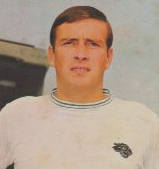 Internationalist winning 13 caps with Derby County. He was a protégé of Brian Clough, and when Clough took over at Nottingham Forest, Solly followed him there. As a result John was a member of the team that won the European Cup in 1980, joining a small band of Scotsmen who have done so, its only Vale representative.
Internationalist winning 13 caps with Derby County. He was a protégé of Brian Clough, and when Clough took over at Nottingham Forest, Solly followed him there. As a result John was a member of the team that won the European Cup in 1980, joining a small band of Scotsmen who have done so, its only Vale representative.
John lives and works in Derby but has many relations and friends in the Vale. There have been other Renton men who made their name in football - Dannie Currie of Clyde in the 1950's and early 1960's. And, of course, Hughie Gallacher, brother of another of Renton's sporting sons, Skeets.
Hughie was a favourite of the whole area in the mid-1950's to the early 1960's. He was Dumbarton's centre forward in the late 1950's when they always threatened to be promoted from the old Scottish B League to the big time of the Scottish A Division. A large part of that threat came from the goal scoring exploits of Hughie. Although he was only 5' 7” (the same height as Alex Jackson), in his 8 seasons at Boghead - he joined in season 1954-55 and spent part of 1960-61 playing in A Division for Clyde - Hughie played 220 games and scored 205 for the Sons.
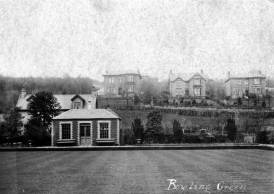 Football was not, of course, the only sport to attract Rantonians. Before the football club had even been founded, Renton Bowling Club opened in 1866 on its present site.
Football was not, of course, the only sport to attract Rantonians. Before the football club had even been founded, Renton Bowling Club opened in 1866 on its present site.
It was the first Bowling Club in the valley, pre-dating Alexandria by a year, a fact which did not go unnoticed then, nor ever since. There was also a bowling green behind what was the Bowling Green Tavern, at the north end of Main Street, but it disappeared in the 1920's with the building of Hillfoot.
Quoiting was another sport in which Renton excelled from the early days. Although it has almost completely disappeared now, for much of the 20th century it was a very popular sport in working class parts of Scotland - particularly in the Vale and in Ayrshire. The Renton Quoiting Club was at the bottom of Burns Street and survived until the redevelopment of the 1960's. It produced many champions in its day, being the Scottish Championship Club in 1949.
It was also a popular and lively social centre until its demise, its hut being the right size for many of Renton's social and charity functions. Even its dusty ring was pressed into service on summer nights as an ad-hoc dance floor. The members of the Black family were famous both as quoiters and pigeon racers, and the last of the local quoiting world champions, Billy Black, sadly just recently passed away (September 2007).
Pigeon racing was another sport in which Rantonians did and still do, excel. For much of the 20th century, greyhound and whippet training and racing were very popular too, and the sight of a couple of men walking a 6-7 dogs each, out the Renton road or through the Vale, was a very common one. The dogs were raced at tracks around Glasgow - most now gone. That greyhound racing survived through good and bad times suggests that owners and punters, no doubt taking advantage of the sport's customary fair means and foul, made money.
Every Rantonian of course, took these means in with their mother's milk. In fact, the sport continues at a more modest level, and dogs and walkers can still be encountered on the towpath between Cordale and Dalquhurn Points. Renton and fighting became synonymous in the early 20th century - a reputation which Renton soon learned to turn to its advantage - and if the fighting was originally of the street variety, Renton also produced a number of good boxers, the best known of whom, Skeets Gallacher, was a world-class flyweight in the 1940's. Skeets was involved in training youngsters in Renton for many years. He passed away in 2013.
Page 1 | Page 2 | Page 4 | Page 5

